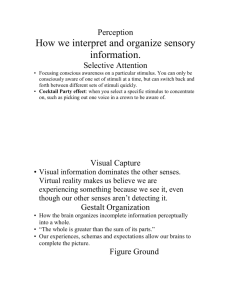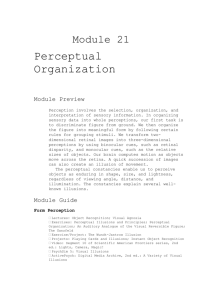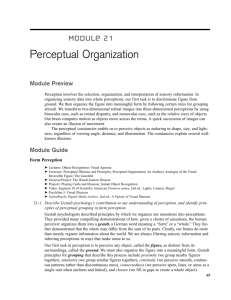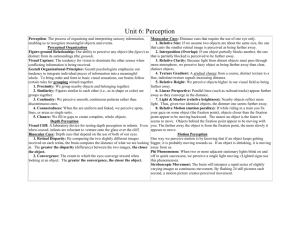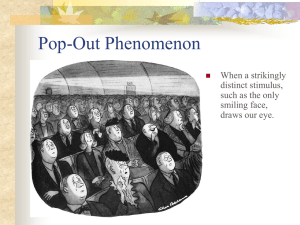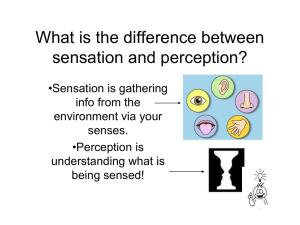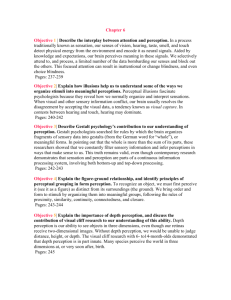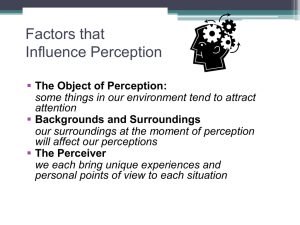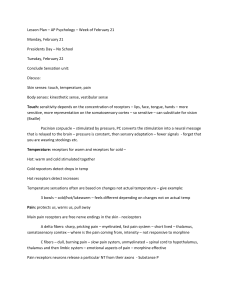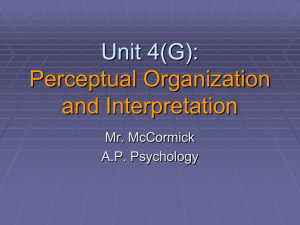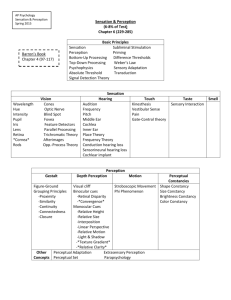Perception Note Taking Guide AP- Answers
advertisement
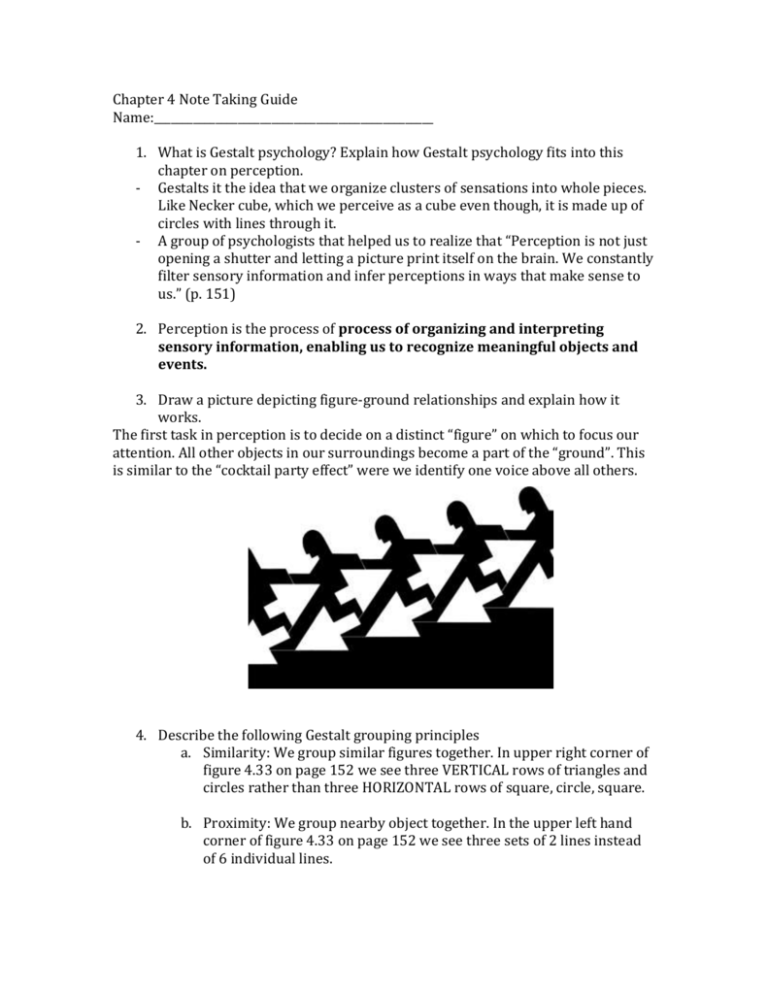
Chapter 4 Note Taking Guide Name:__________________________________________________ 1. What is Gestalt psychology? Explain how Gestalt psychology fits into this chapter on perception. - Gestalts it the idea that we organize clusters of sensations into whole pieces. Like Necker cube, which we perceive as a cube even though, it is made up of circles with lines through it. - A group of psychologists that helped us to realize that “Perception is not just opening a shutter and letting a picture print itself on the brain. We constantly filter sensory information and infer perceptions in ways that make sense to us.” (p. 151) 2. Perception is the process of process of organizing and interpreting sensory information, enabling us to recognize meaningful objects and events. 3. Draw a picture depicting figure-ground relationships and explain how it works. The first task in perception is to decide on a distinct “figure” on which to focus our attention. All other objects in our surroundings become a part of the “ground”. This is similar to the “cocktail party effect” were we identify one voice above all others. 4. Describe the following Gestalt grouping principles a. Similarity: We group similar figures together. In upper right corner of figure 4.33 on page 152 we see three VERTICAL rows of triangles and circles rather than three HORIZONTAL rows of square, circle, square. b. Proximity: We group nearby object together. In the upper left hand corner of figure 4.33 on page 152 we see three sets of 2 lines instead of 6 individual lines. c. Closure: We fill in empty gaps in order to create a whole object. In figure 4.34 on page 152 we see to whole triangles rather than circles with missing pieces. d. Continuity: We perceive smooth continuous patterns rather than discontinuous patterns. In bottom left corner of figure 4.33 on page 152 we see two continuous lines that intersect rather than individual pieces. 5. The ability to see in three dimensions and judge distance is called Depth Perception. 6. What is the Visual Cliff? - A glass covered drop-off used to determine whether crawling infants can perceive depth. This was an experiment conducted on 6-14 month old children. 7. Compare and contrast binocular and monocular cues. - Binocular cues require the use of two eyes in order to make sense of a stimulus. o Retinal Disparity: a binocular cure for perceiving depth. By comparing images in both retinas the brain determines the distance of the object. - Monocular cues only require the use of one eye in order to make sense of the cue. o There are many monocular cues including relative light, relative size, interposition, linear perspective, light and shadow, and relative motion 8. Describe the following monocular cues. a. Relative Size: Objects in our field of vision that are higher as farther way. This is because when an object is closer to the ground we believe it to be closer to use. This is illustrated on page 155. b. Relative Motion: As we move, like in a car, stable object appear to move with us. The farther the object is from that place of your visual fixation, the faster it seems to move. c. Interposition: If one object blocks our view of another we perceive the first object as closer together. d. Relative Height: If we assume that objects are about the same size (like 2 people) then we perceive the smaller image as farther away. e. Linear Perspective: Parallel lines appear to converge when looking off into the distance. Ponzo Illusion. f. Light and Shadow: Nearby objects reflect more light to our eyes. Therefore, given two objects the dimmer one seems farther away. 9. What is stroboscopic movement? - When our brain perceive a series of rapidly changing and slightly varying pictures as a continuous movement. Like a cartoon. 10. Why is the ability to perceive motion so important? - We would have trouble biking, driving and even walking with any consistency. We perceive that shrinking objects are getting farther away and bigger objects are getting closer which allows us to judge distance while moving at faster speeds. 11. Perceptual constancy is recognizing objects without be deceived by the Shape, Size, and brightness. 12. Why is perceptual constancy important? - It allows us to perceive objects without being fooled by changes in there shape and size. This allows us to make perceptual decisions much quicker than if we had to continually readjust our perception. 13. What is shape constancy and what do figures, 4.40 and 4.41 on pages 156- 57 have to do with shape constancy? - Both figures demonstrate shape constancy. In figure 4.40 we can still tell that we are looking are a rectangular table even though they have been moved so that it looks like one may be longer than the other. In figure 4.41 we can still tell we are looking at a door regardless of changes to its orientation. 14. Describe Lightness and color constancy. Describe a scenario, not used in the book, where these forms of perception would be useful. - Lightness constancy is the idea that we perceive a white piece of paper as white regardless of the amount of illumination it receives. - Color Constancy is the idea that we perceive similar objects as having the same color despite changing illumination and wavelengths. 15. What happened to Mike May and what does this have to do with perception? - At the age of 3 Mike May lost his vision. In 2000 his vision was restored after many years of being blind. Due to the fact that his visual cortex had been under developed his had trouble recognizing faces and expressions. - This tells us that perception is in part learned. Because his brain had no need to exercise its visual perception Mike May’s abilities were several underdeveloped. 16. In the Discovering Psychology: Sensation and Perception video there was a scenario where a football player had to adapt to a new perceptual set. How is this similar to the scenario describing perceptual adaptation on page 160? - Perceptual Adaptation is the ability to adjust to an artificially displaced or even inverted visual field. - In the study on page 160 chicks were fitted with goggles that distorted their view of the world. They were unable to adapt to these changes. - As humans we have the ability to make the necessary adaptations to our perception when things change like the football player whose field of was distorted by goggles. 17. What is a perceptual set? - A mental predisposition to perceive one thing and not another. 18. How does our perceptual set relate to top-down Processing? - When told that an adult and child are related we begin to see similarities that we may not have noticed previously. This is relying on our prior knowledge about he adult and child to make a perceptual decision, which is know at topdown processing. - In the same way once we have formed a wrong perception it become harder to correct. Examples of this are the Loch Ness monster and UFO’s. We have trouble seeing any except the Loch Ness monster when looking at the famed photo so we cannot identify what it may actually be. 19. How do our expectations and past experiences affect our perception of our current surroundings? - The entire idea of stereotypes relies on our past experiences to construct our perceptual world. If we grow up being told that a group of people is stupid or lazy without any experience to the contrary, we will assume anyone we meet from that groups as lazy and stupid. - If we have a bad experience at a Denny’s we may never go to any Denny’s anywhere ever again because we will perceive them all as negative establishments. 20. What is extrasensory perception? What experiments have been done concerning extrasensory perception? - The claim that perception can occur apart from sensory input. o Telepathy: mind to mind communication o Clairvoyance: perceiving remote events like sensing a friend’s house is on fire. o Precognition: perceiving future events before they happen. -
